Description
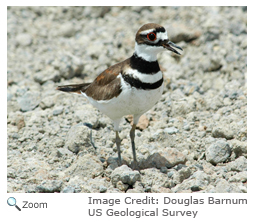 The killdeer has brown upper sides and white undersides. It has a a brown head with a black band between its eyes, white eyebrows, and black bands around its upper chest. It has a sharp, black bill; long legs; and a long tail. Males and females look the same. The killdeer has brown upper sides and white undersides. It has a a brown head with a black band between its eyes, white eyebrows, and black bands around its upper chest. It has a sharp, black bill; long legs; and a long tail. Males and females look the same.
Range 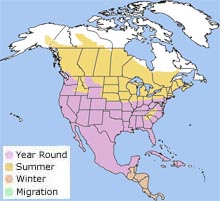 The killdeer is found from Alaska to Newfoundland south throughout the United States and into Mexico, Central America, the Caribbean, and South America. The killdeer is found from Alaska to Newfoundland south throughout the United States and into Mexico, Central America, the Caribbean, and South America.
Habitat 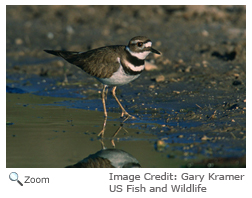 The killdeer is found in open grasslands, wetlands, fields, pastures, and short-grass prairies. It is often found on sandbars, mudflats, and pastures. The killdeer is found in open grasslands, wetlands, fields, pastures, and short-grass prairies. It is often found on sandbars, mudflats, and pastures.
| |
DietInsects make up the majority of the killdeer's diet, but it also eats berries and crustaceans.
Life Cycle 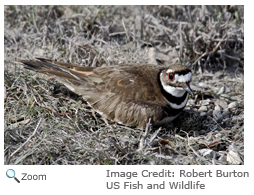 The male killdeer claims a nesting territory before selecting a mate. To attract a mate, the male stands in his territory and makes a two-note call for hours at a time. The male may also scrape at the ground and fly over his territory. Once killdeers have mated, the pair scrapes out a nesting site. The female killdeer lays an average of four eggs. Both the male and the female incubate the eggs. It takes about 24-28 days for the eggs to hatch. The male killdeer claims a nesting territory before selecting a mate. To attract a mate, the male stands in his territory and makes a two-note call for hours at a time. The male may also scrape at the ground and fly over his territory. Once killdeers have mated, the pair scrapes out a nesting site. The female killdeer lays an average of four eggs. Both the male and the female incubate the eggs. It takes about 24-28 days for the eggs to hatch.
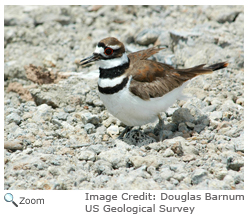 The chicks are precocial, that means they can move around and feed themselves shortly after birth. Once the chicks' down dries, the parents lead them to a feeding area. The chicks stay with their parents until they fledge a month after birth. The killdeer may have two broods a year. The chicks are precocial, that means they can move around and feed themselves shortly after birth. Once the chicks' down dries, the parents lead them to a feeding area. The chicks stay with their parents until they fledge a month after birth. The killdeer may have two broods a year.
Behavior 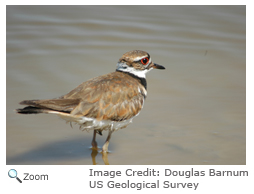 Killdeer do not gather in flocks. They are solitary or in male and female pairs. The killdeer sometimes distracts predators from its nest by pretending to be injured. It drags itself along the ground, sometimes on one foot, dragging its wings like they are broken. When the predator turns its attention to the killdeer and away from the nest, the adult killdeer flies away. Killdeer do not gather in flocks. They are solitary or in male and female pairs. The killdeer sometimes distracts predators from its nest by pretending to be injured. It drags itself along the ground, sometimes on one foot, dragging its wings like they are broken. When the predator turns its attention to the killdeer and away from the nest, the adult killdeer flies away.
|


 The killdeer is found from Alaska to Newfoundland south throughout the United States and into Mexico, Central America, the Caribbean, and South America.
The killdeer is found from Alaska to Newfoundland south throughout the United States and into Mexico, Central America, the Caribbean, and South America.



